
Using Resistors In Guitars – 101
When you think of tone shaping, a couple of items might come to mind. We all use pickups, capacitors (tone caps), and pots as tone shapers. However, using Resistors in a guitar can open up new tonal possibilities as well.
A Resistor is a device with a measurable amount of resistance. Simply put, a Resistor impedes the flow of or “resists” electricity. One way to think of a resistor is by using the ‘Pipe analogy.’
Imagine a pipe with free-flowing water in it. Then, imagine that the water has to go through a much smaller gauge pipe where the flow is “resisted.” This analogy describes how a resistor works in simple terms: it creates a higher point of resistance in the flow of electricity.
I’m sure you’re thinking “Cool. But, how does a resistor affect my guitar?” We’re glad you asked! Today, we’re going to illustrate some basic examples of how to use resistors in a guitar.
PARTIAL SPLIT RESISTOR:
One of the most basic examples of resistors in a guitar is with our Partial Split Resistor. The Partial Split Resistor gives low-output humbuckers a stronger single-coil tone when split. This is a common problem when splitting your humbucker – not all humbuckers are equal.
Removing one coil from a lower-output humbucker, like our Pure P.A.F., leaves you with a weak-sounding single-coil tone. Using a resistor can make all the difference. For an in-depth article on coil-splitting, head to our article here.
HOW TO WIRE IT UP:
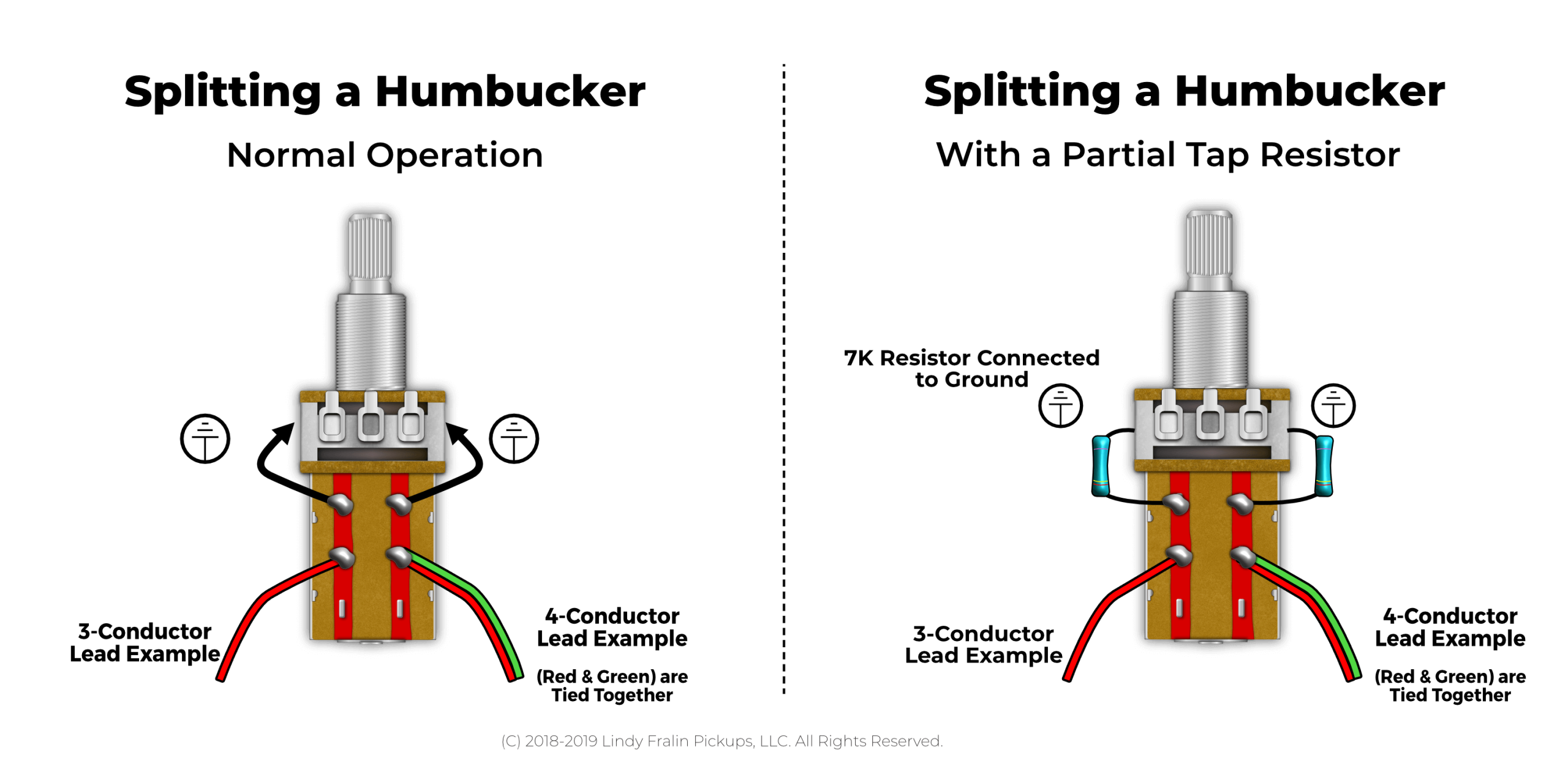
Using a Partial Tap Resistor is an easy way to explain resistors in a guitar. It takes the place of whatever you’re using to connect to ground. Instead of using wire as your ground connection, use a resistor instead. Using one will give you a stronger coil tapped tone when you pull up. See below for an illustration to help you wire it up.
HOW IT WORKS:
Simple. A Resistor is “Resisting” the flow of electricity, so, when you pull up, instead of sending 50% of the Humbucker to ground, it will only send, say, 33% of it. This allows you to have a stronger single-coil tone when pulled up.
FAKING OUT YOUR SINGLE COILS WITH RESISTORS:
Alright “faking out” seems a little vindictive. However, when you have a Telecaster with a Humbucker in the Neck and a Single Coil in the bridge, it can be tough to make those two pickups play nicely together (read our in-depth article on this topic here).
WHEN TO DO IT:
Let’s set the stage: You have a Telecaster with a Humbucker in the neck and a Single Coil in the Bridge. The Humbucker needs a 500K pot to sound good, and Single Coil sounds best on 250K pots. You only have one volume pot – how can you compromise? Put a Resistor From The Bridge Pickup Hot To Ground.
HOW TO WIRE IT UP:
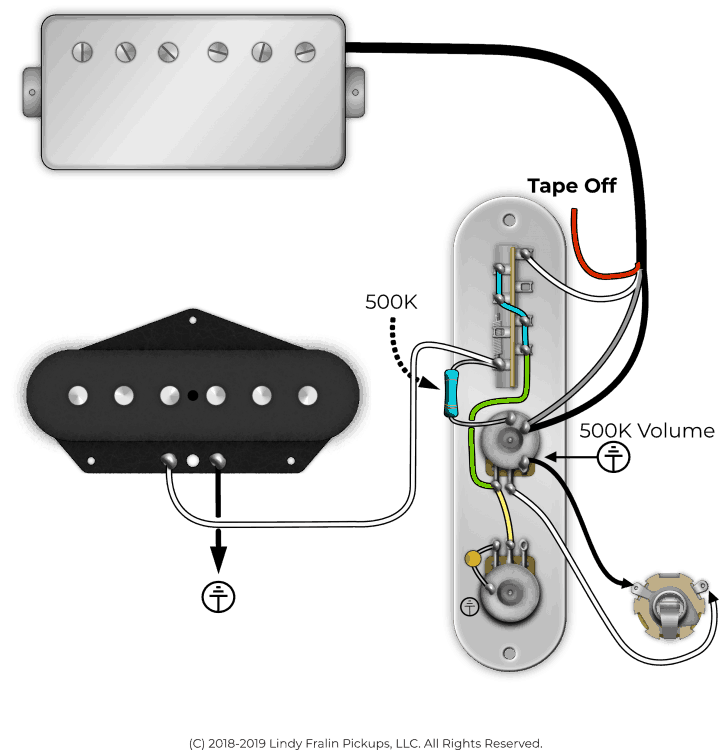
HOW DOES IT WORK?
Let’s explain this using a simple formula. When you use two resistors in Parallel, one side of each resistor connects to the same location. For example, your Volume Pot is a resistor: 250K, 500K, these are resistance values.
One side of the pot is a “hot,” or “input,” and one side of the pot is Ground. If you attach a resistor from the “Hot” of a pickup, and one leg to “ground,” you’re putting that resistor in Parallel. See below for the equation of using 2 Resistors in Parallel:

As you see, if you put a 500K resistor in parallel with a 500K pot, the Bridge Pickup will “see” a 250K pot. This is great for your Telecaster as it you’ll have a great sounding Neck Humbucker and a perfect-sounding Bridge Single Coil.
NOTE:
The above formula works well when you’re on your Neck pickup and Bridge Pickup only. However, when you get in the Middle Position, you’re adding yet another resistor. Your Neck Pickup (500K) Your Bridge Pickup (500K) and the Parallel Resistor (~470K). When you combine your neck and bridge using this resistor trick, the middle position will see a 163K pot, making it darker than usual.
TRANSFORM YOUR POTS:
In our last example, you can use a resistor in a guitar to change your pot value. This is handy when you only have a 500K pot on hand, but you need a 250K pot. If you have a ~500K Resistor, you can make this happen! See below for a diagram on how to wire this up:
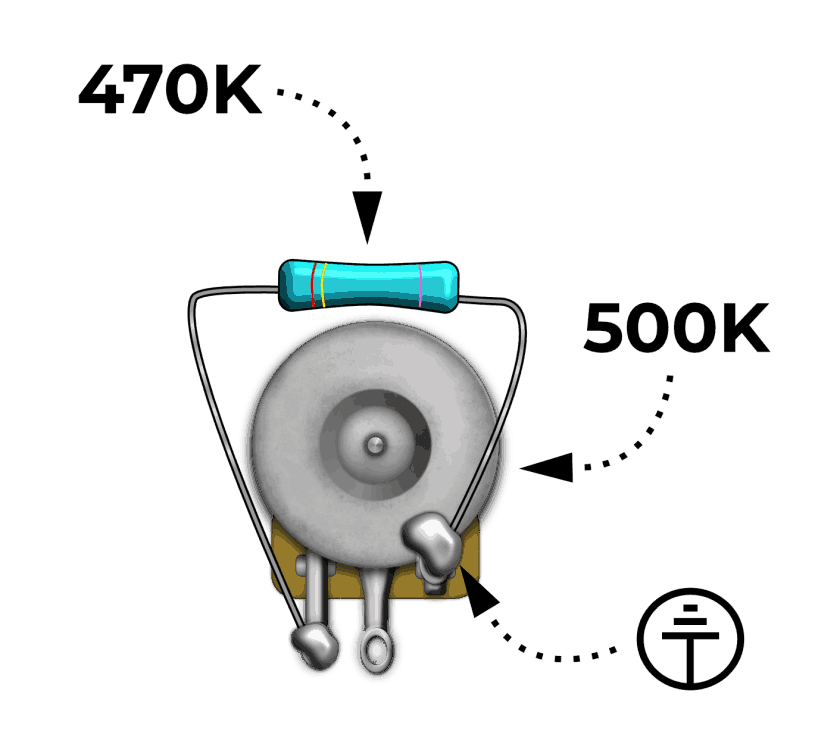
In the above image, you have a 470K resistor in Parallel with your Volume Pot. The pot value’s resistance is 500K, and your Resistor is 470K – with a combined resistance of 242K. Pretty neat!
Want to know more about selecting pots and how they work? Read up on that here!
You can use this trick to take a bit of high-end off of your pots as well. Let’s say you have a 500K pot, and your pickups are just a little too bright on them: you can add a 1Meg resistor like the image above, and you’ve turned your 500K pot into a 333K pot. This will tame some of the highs.
Thank you for reading. There are lots of great articles out there to learn how resistors work, and what you can use them for. There is a multitude of ways to add a resistor to your guitar’s kit. How do you do it?
Comments
58 Comments For This Post
Leave A Comment
Want to chime in to the conversation? Please do so! Please respect others.



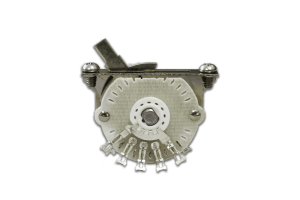
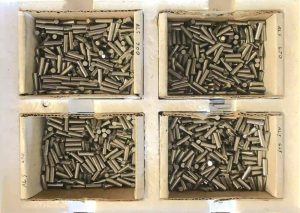
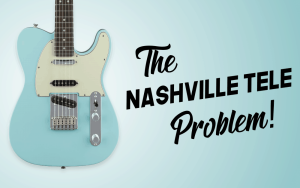

Tyler I’m a little confused about something. I understand that to put a humbucker in the neck of a telecaster, you need to put a 500k resister in parallel with a 500k pot in order for the bridge to “see” a 250k pot. But what I don’t understand is the middle position. What is the proper way to wire the middle position so that both pickups are evenly together?
Hey John,
It’s pretty hard to make it work on paper – we haven’t found a way to do it properly. However, in practice, you get a usable tone with good balance anyway. We tested this and we found that we like the middle position, even if the resistance reading is something like 163K.
In the case of a neck hum / bridge single setup with a 500k pot on a tele, it is possible to wire your 3 way switch in such a way that a 500k resistor in parallel with the bridge pickup does NOT affect the middle position. The entire switch would need to be rewired with the common lugs connected to the output. Then you can use the third lug on the neck pole side of the switch for the resistor – it will be taken out of the circuit in the 2 and 3 positions, and the bridge pickup will only “see” a 250k pot in the 1 position.
First side of switch:
1st Lug – Bridge Pickup
2nd Lug – Jumper to lug 1 (Bridge Pickup)
3rd Lug – EMPTY
Common – connected to Common on 2nd side of switch and connected to 500k Volume Pot input
Second side of switch:
Common – connected to Common on 1st side of switch and connected to 500k Volume Pot input
1st Lug – 500k resistor (other side to ground)
2nd lug – jumper to lug 3 (Neck Pickup)
3rd lug – Neck Pickup
The wiring diagram seems wrong to me. You’ve only got half the humbucker wired up. The negative of one side of the humbucker should go to ground on top of the pot along with the case ground wire, the hot wire from that side of the humbucker should then connect the negative of the other humbucker then the hot from that one hits the switch. You have the red wire taped off and the white hot wire in use, you’re only using one of two coils.
It’s not wrong – our Red is both the Slug and Screw coil ‘finish’. They are connected in series at the humbucker, but a lead is run off of that connection to send that to ground, if necessary. Doing so will send the slug coil completely to ground as it’s ‘start’ is already connected to ground (black). Doing this will leave the screw coil intact. In this case, however, since the red is not connected to ground and is taped off, the humbucker is still connected in series at the humbucker itself. Hope that clears it up.
Hey.
Great Article.
I have a Fender Player Series 2018 Jazzmaster with Humbuckers and the Coil-Split Feature on the Push-Pull Tone-Knob.
Wiring and used Parts can be found here on Page 4: https://www.fmicassets.com/Damroot/Original/10001/SM_0146903XXX_Player_Jazzmaster_Rev_A.pdf
I have the exact problem that in SC-Mode the Output (Volume) gets way lower. And in the SC-Mode the Sound is also very thin (trebly).
Would the PARTIAL SPLIT RESISTOR Mod help here?
Can i just solder in the 7K Resistors like in the Diagram you shared here?
Any other mods suggested for a not so bright (trebly) sound?
Higher Quality Pots, Switches, Input-Jack? (Don’t really have the money for new pickups ;-))
Thanks for help in advance!
Greetings
Daniel
Tyler I’m a little confused about something. I understand that to put a humbucker in the neck of a telecaster, you need to put a 500k resister in parallel with a 500k pot in order for the bridge to “see” a 250k pot. But what I don’t understand is the middle position. What is the proper way to wire the middle position so that both pickups are evenly together?
hello guys , I NEED HELP
I will use 2 humbuckers and use push pull 500k with “Partial Tap Resistor!”, I would like to know when I split coils, use only one coil, how do I see only 250 k pot in single coil mode?
Best Regards
That’s a really good question. Just off the top of my head, you may be able to kick in a 500K resistor with the second side of the switch. However – we find that you get a really good-sounding Single Coil tone with the Partial Tap Resistor on 500k pots anyway.
Ronaldo. The real issue is what does your ear like to hear? So what is soothing to your taste probably isn’t for the next player. Tyler is correct…single coil for some sounds great through 500k pot. There is not a one fits all answer. If you follow what Tyler suggested. 500k x 500k equals 250k. Crazy huh? So experiment. Keep chasing tone. All the best
Partial tap resistor work 6800 ohm or 6k8 resistor ? Any W , any tolerance ? In my country don’t have 7k resistor in eletrônic stores
Very Thanks , best regards
The push pulls I bought ‘One volume one tone. it Volume I’m putting the Volume kit on it The other push pull I want to put two different caps on it. the push pulls I have are different than any wiring I saw. It has 3 tabs 6 small holes C1 1 2 3 4 C2 Is there a wiring diagram for this
I added a 1.5 Mohm resistor to a 500k pot (really it is 520k) which really worked well for me but doing this killed the taper of my volume. Is this normal and would I be better off with a linear pot instead of audio taper?
It seems to me the resistor could be added to the ground of a weak coil using a 5 way super switch. Also, in an HSH config with 500k pots, the middle single could have an added resistor to warm it up a little. Am I right that this would work?
Tyler.
I have a recent build using tele baja controls. The pickups are p90 neck strat bridge. Now these are boutique pickups and reported as a good match. However the p90 is much louder. The solution I’m hearing is find the neck pickup that is a better match. Would a second solution be ditch the baja controls and go with a 4 pot lele control setup where each pickup has separate tone and volume. I’m in a learn mode. You are teaching me.
Hi all,
I have an old Silvertone with 2 lipstick pickups that is wired with 500k pots all around. So, according to this schematic, I need to put a 470k resistor across the 1 and 3 lugs of the volume pots only? What about the tone pots? Thanks in advance for any help.
In the case of a neck hum / bridge single setup with a 500k pot on a tele, it is possible to wire your 3 way switch in such a way that a 500k resistor in parallel with the bridge pickup does NOT affect the middle position. The entire switch would need to be rewired more like a strat – the common lugs connected to the output. Then you can use the third lug on the neck pole side of the switch for the resistor – it will be taken out of the circuit in the 2 and 3 positions, and the bridge pickup will only “see” a 250k pot in the 1 position.
I’ve been wrestling with this exact issue on my Telecaster: PAF humbucker in the neck, low to medium output alnico II Tele bridge pickup. I’ve tried several things and have heard of the resistor trick but never with an adequate explanation that really helped me to see a) how to do it and b) how it works. So I’ve been reluctant to try. Now I definitely want to try this. I’ve currently got it set up with two volumes, no tone (another tip I picked up here) which isn’t exactly working how I thought it would – very noisy which is probably a grounding issue but I’ve been through all that and my grounding seems pretty solid.
One question I have looking at this diagram: the bridge has a ground indicator but where exactly is the ground wire from the bridge pickup supposed to go? This is probably something obvious but it’s confusing to me because the neck actually shows where the ground wire goes to the volume pot but there’s no similar indicator for the bridge.
Thanks!
Tyler,
2 of my favorite Telecaster players were Al Jackson of Earth, Wind and Fire, and Cornell Dupree of King Curtis( Aretha Franklins’ ryhthm section) as well as the Motown session guitarists. Each of them favored Tele’s which sported a humbucker in the neck position. Their tones were unique and yet the output between the humbucker and the bridge pickup were equal. From what modification of resistors did they achieve this?
John Carmody Seattle
Hey John,
It’s tough to say for sure. Really, the best option is to do your best to match outputs. For instance, going with a Low Output Humbucker in the Neck (Pure P.A.F.) and a higher-output pickup in the bridge (Blues Special, Blues Output Split Blade) will be the best option. The resistor trick is simply a band-aid for a more complicated problem.
Couldn’t the path through the resistor be wired to an on-off switch? That way you could have the pot at its full value, normally, but, if you flip the switch, you can engage the added resistor and diminish the total resistance?
Is there a way to ease back output on a dimarzio super distortion bridge pickup? Sound great but just blow the neck pu away
Hey Frank,
No – that pickup is designed to be super loud and high output. The only advisable option is to replace it with something more in-line with your current setup.
Tyler
Hey! Great article. But I have a question. I’ve got an Ibanez with HSH configuration, 5 way switch with auto-split humbuckers, 1 volume(500k) and 1 tone(500k). So It’s neck seriesHH /neck south with middle single/middle single/single+north bridge/bridge series HH. Switch is standard Ibanez(import) 5 way. So my question is: Is it possible and/or useful to incorporate resistor(s) in chain to make middle single pickup sound better and will it be noticeable in position 2 and 4 with split humbuckers? Thanks in advance!
Hey Yurii,
It’s tricky to tell as I can’t study your wiring, and I haven’t had experience with something like this before. If anyone can comment on this, that would be helpful.
It’s kinda common Ibanez wiring for their HSH with 5 way switch equipped guitars… For example it’s used on Steve Vais signature Ibanez JEM7V and so on. I found wiring diagrams in internet and after inspecting mine=) They use 3c (hot, tap(?) and ground) humbuckers in older models, and 4c in newer . It’s pretty simple wiring I guess, but question is: Does it make sense to use resistor for middle single ? Maybe when middle single is weaker then even splitted neck humbucker?
Can you tell me where I can find a Wiring Diagram that shows me how to hook the blending pot up to a Fender Stratocaster? I can’t find it on your website.
Thank You
Jim Northrup
Hey Jim,
Yes – it is located at the bottom of the page here: https://www.fralinpickups.com/fralin-wiring-diagrams/
Tyler
Great article, very useful explanations. Never thought of doing that on a coil tap or neck hum bucker/bridge single coil…I just encountered a Tele where the neck was a single and bridge a mini hum (hot rails type)…would I put a resistor on the neck in this case? Problem was, the bridge was wayyyy louder than the neck.
Hey there,
I don’t believe the resistor will help you there. This is an issue with pickup outputs – Hot Rails are a very loud and high output pickup. This is due to both coils wrapped around steel plates. The design of the pickup leads to a very strong signal. What would help you in this situation is finding two pickups that will match up in output a little better.
Tyler
last sentence has an error I think:
“Let’s say you have a 500K pot, and your pickups are just a little too bright on them: you can add a 1K resistor like the image above, and you’ve turned your 500K pot into a 333K pot.”
don’t you mean a 1M (mega ohm) resistor ?
Hey Henry,
Good catch! I was thinking in ohms, not Kohms. I’ll get that fixed today. Thank you.
Thanks!I bought a pawn shop Esquire with 500K pot and its just too bright. Now I know what to do.